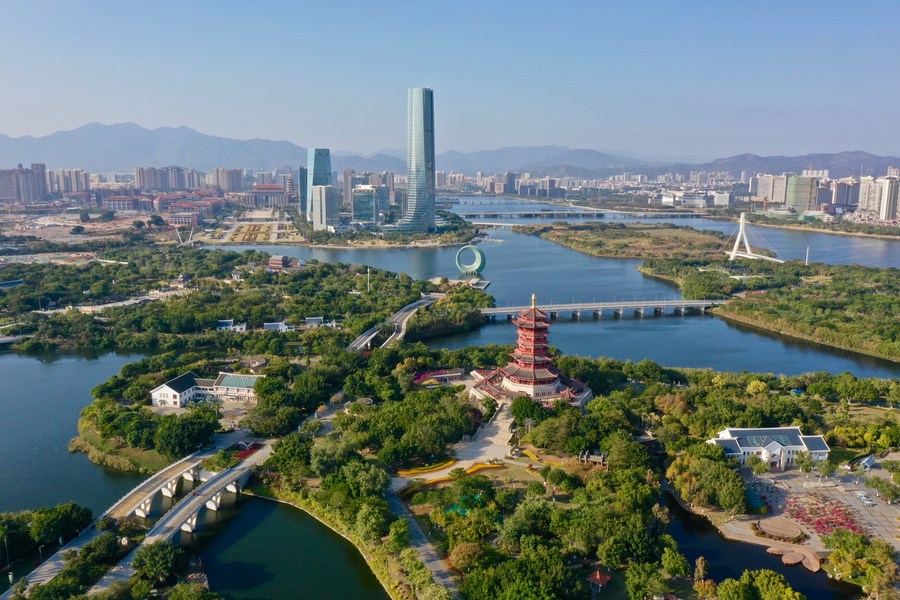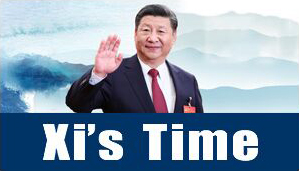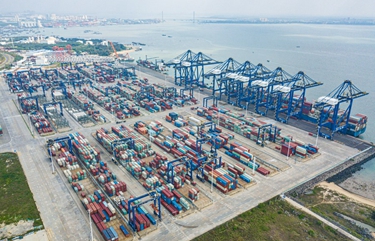
Aerial photo taken on Dec. 8, 2021 shows the city view of Xiamen, southeast China's Fujian Province. (Xinhua/Jiang Kehong)
BEIJING, March 17 (Xinhua) -- A recently released report titled "Toward Modernity: The Value of Xi Jinping's Economic Thought" has explored the origins of Xi's economic thought from the perspective of local governance.
When working in different localities, Xi put forward a series of new ideas, new ways of thinking and new measures concerning economic work. His years of solid practice on the ground have enriched his experience and enhanced the depth of his theoretical thinking, laying a solid foundation for his economic thought to take shape and evolve.
Recounting Xi's stories of economic governance when he worked at local levels, the report, which was released by New China Research, the think tank of Xinhua News Agency, has offered a vivid illustration on how Xi's economic thought helped promote local development.
The following piece tells Xi Jinping's story in Fujian.
From June 1985 to October 2002, Xi Jinping worked in Fujian Province, and held important positions in Xiamen, Ningde, Fuzhou, the Fujian Provincial Committee of the Communist Party of China (CPC), and the provincial government of Fujian, and made a series of practical explorations and conceptual innovations which were forward-looking, pioneering and strategic. Xi once said with deep affection, "Fujian is my second hometown."
Fujian is an important breeding ground of Xi's economic thought and a place where it was put into practice. Xi once pointed out, "Some of the thoughts and explorations I made while working here are still being thought about and deepened in my later work, and some of them have been put into practice on a larger scale across the country."
"JINJIANG EXPERIENCE": AN IMPORTANT INSTRUMENT FOR THE DEVELOPMENT OF PRIVATE ECONOMY
Jinjiang, with the spirit of "daring to be the first in the world and striving hard to win," has transformed from a "high-yield but poor county" with a large population and little land, to "No. 1 in Fujian" and "Top 10 in China" with a developed private economy, creating the "Jinjiang Experience."
While working in Fujian, Xi visited Jinjiang seven times in six years. At that time, Jinjiang took the lead in economic development among county-level regions in Fujian, and its private sector was booming but also faced "growing pains." Xi then conducted research, with private enterprises as the focus. Every time he visited the enterprises, he carefully asked whether they had introduced new technologies and developed new products, how the market was developed, how the enterprise could become bigger, and what difficulties they encountered.
For many times, he encouraged the enterprises to be market-oriented and do a good job in market innovation. In August and October 2002, he published signed articles twice, summarizing and putting forward "Jinjiang Experience" with "Six Adherence" and "Correctly Handling Five Relations" as its core connotations.
Over the years, under the guidance of "Jinjiang Experience," Jinjiang has blazed a path of county-level regional development supported by the private economy and the real economy.
Since the 18th CPC National Congress, Xi has repeatedly mentioned "Jinjiang Experience." He emphasized that "Jinjiang Experience" is still instructive and put forward important instructions such as "focusing on developing industry," "allowing all types of firms to innovate," and "carrying forward entrepreneurial spirit." The "Jinjiang Experience" has been continuously improved and developed in practice and has played a vital role in developing China's private economy.
BUILDING XIAMEN SPECIAL ECONOMIC ZONE: A KEY MOVE OF REFORM AND OPENING UP
Xiamen has been a trading port since ancient times as well as a gateway for China's opening up and external cooperation. It is also one of the four earliest special economic zones in the country.
From June 1985 to June 1988, Xi served as Member of the Standing Committee of the CPC Xiamen Municipal Committee, vice mayor, and executive vice mayor of Xiamen. He once recalled, "to work in the special economic zone was the first time that I took a leadership position at the municipal level, the first time that I directly participated in the work of reform and opening up in the more developed coastal region, and the first time that I personally engaged in the development and management of a city."
Adamant about pressing ahead with reforms, Xi was brave enough to blaze new trails in Xiamen. He once said, "The socialist cause will never progress without reform and opening up." He also noted that "reforms might present risks, but the country needs pathfinders who, when they succeed, will provide experience for and play an instrumental role in the country's future reforms."
He proposed the principle of "small government, big society" for the first time in China, supported financial institutions in operating like enterprises, and oversaw the establishment of investment companies by overseas Chinese, regional insurance institutions, and a center in Xiamen to regulate foreign exchange.
The bold, pragmatic, and effective measures of reform injected great vitality into Xiamen's economic and social development. He also led the formulation of a strategy for Xiamen's economic and social development from 1985 to 2000, which served as a blueprint for the medium- and long-term development of the city.
"Xiamen," he wrote in a 1986 speech, "means 'the gate of a mansion.' We can also view it as the gate of opening up to the outside world and sincerely hope that it will develop faster and better." He once led a research team to Singapore and organized China's first international seminar on export processing zones and free ports. After years of development, the Xiamen Special Economic Zone has evolved, with a deepening level of opening up, from an export processing zone, a bonded zone, a coordinated bonded port zone, and a bonded port area to a pilot free trade zone.
POVERTY ALLEVIATION: PROMOTING THE DEVELOPMENT OF LESS-DEVELOPED NINGDE
Xiadang Township in Shouning County of Ningde Prefecture is tucked deep in the mountains in eastern Fujian. Covered mostly by mountains and with scarce farmland, Xiadang had for a long time been a place with no roads, no tap water, no electric lighting, no fiscal revenue, and no government offices.
While working in Fujian, Xi made three arduous trips to Xiadang. During his first visit on July 19, 1989, he spent five hours by car and four and a half hours on foot visiting villagers and worked a total of 14 hours that day from 6 a.m. to 8 p.m.
"I will never forget the trip for the rest of my life," Xi said emotionally. "We will feel ashamed in the face of our fellow villagers if Xiadang is not lifted out of poverty."
Xiadang was a typical place in Ningde where poverty hindered development at that time. From June 1988 to June 1990, Xi served as the secretary of the CPC Ningde Prefectural Committee.
Working in the less-developed eastern Fujian following a stint in Xiamen, Xi thought deeply and at length about how to lift a region out of poverty. Leading cadres and the people in pursuing development, he supported poor regions in getting a head start, advocated a coordinated economic growth model, and stressed the importance of making persistent efforts in seeking development.
Xi pointed out that it is necessary to have the consciousness of "flying first," and put forward the idea of "boosting the confidence before relieving poverty." He called on people to abandon ideas such as "being content with a poor life" and "just waiting for, relying on and asking for the poverty-relief fund."
In practice, Xi emphasized adapting to local conditions. He pointed out that in order to make weak birds fly early, fast and high, it is necessary to explore ways to develop an economy according to local conditions. Regarding how to develop township enterprises in poverty-stricken areas, Xi pointed out that we must seek four footholds of "experts," "agriculture," "specialty" and "outside."
Now, when people walk into Xiadang Township, they will be impressed by marvelous and picturesque views of mountains, bridges and streams, while the air is filled with the smell of flowers, fruits and tea. After decades of joint efforts, Xiadang has developed from a poverty-stricken place to a well-known "new landmark of red tourism."
BUILDING "DIGITAL FUJIAN": SEIZING THE COMMANDING HEIGHTS OF SCIENCE AND TECHNOLOGY
Ahead of the National Day in 2000, a "'Digital Fujian' Project Proposal" was placed on the desk of Xi who was then the governor of Fujian.
In a full page of instructions, Xi put forward that "to implement the strategy of revitalizing the province through science and education, we must seize the commanding heights of science and technology. Building 'Digital Fujian' reflects one of the most important commanding heights of science and technology in the world today." Soon after that, "Digital Fujian" was written into the outline proposal of the 10th Five-Year Plan put forward by the CPC Fujian Provincial Committee. Xi served as head of the leading group of the Fujian Provincial Government for the construction of "Digital Fujian."
"Digital Fujian" was a major project led and promoted by Xi in Fujian, which profoundly boosted the economic and social development of Fujian and became the exploration source and practical starting point of the construction of digital China.
Xi asked cadres and civil servants to strengthen efforts in "eliminating information illiteracy." He wrote in the article "Digital Fujian Coming to Us" published in February 2002: "Informatization is the general trend of today's world economic and social development, and it is a key step to the optimization and upgrading of industries and achieving modernization both in our country and in our province. None of the four modernizations can do without informatization."
"3820" STRATEGIC PROJECT: DRAWING A BLUEPRINT FOR THE FUTURE
The city of Fuzhou is surrounded by mountains and rivers. People there were afraid of flood and fire, because most houses were made of wood. When a fire broke out in one house, a large area of the city would suffer together. Whenever the Minjiang River flooded, houses would fill with water. Hence, the city was given the nickname "Paper Fuzhou City."
A project, named the "3820" strategic project, has brought about the transformation from "Paper Fuzhou City" to "Happy Fuzhou City".
In 1993, Xi, then Party chief of Fuzhou, presided over "Fuzhou City's 20-Year Economic and Social Development Strategic Vision," which systematically planned the goals, steps, layout and key points of the three-year, eight-year and 20-year economic and social development of Fuzhou, defined the grand goal of "building a modern international city," and established the general program and general plan for Fuzhou's long-term development.
Under Xi's leadership, Fuzhou organized tens of thousands of people to complete questionnaires, thousands of people to do research, and hundreds of people to discuss the strategy.
With the implementation of the "3820" strategic project, Fuzhou has ushered in great changes, and achieved a leap from "sitting in the back row" to courageously striving for the best, from "Paper Fuzhou City" to a livable and happy city, and from a riverside city to a coastal city.
Xi laid out the plan with a forward-looking vision, and promoted the construction of "Golden Triangle Economic Circle at Minjiang Estuary" and "Fuzhou at Sea" as important components of the "3820" strategic project.
At that time, some people wondered, "How can we manage the sea when the land is not well developed yet?" Xi proposed to "attach as much importance to sea areas as to cultivated land, and as much to marine development as to food production, so as to extend the tentacles of speeding up economic development from land to sea." Now Fuzhou has developed into a coastal city with one of the most active marine economies.
At the 7th Party congress of Fuzhou in August 1995, Xi made clear the goal of "striving to build a modern international city." That is, on the basis of the "3820" strategic project, Fuzhou will strive to join the ranks of the international advanced cities after another 20 or 30 years.
"The development of a city should not only consider the medium- and long-term development goals of 10 years and 20 years, but also consider the long-term development goals of 30 years, 50 years or even hundreds of years," he pointed out. ■





